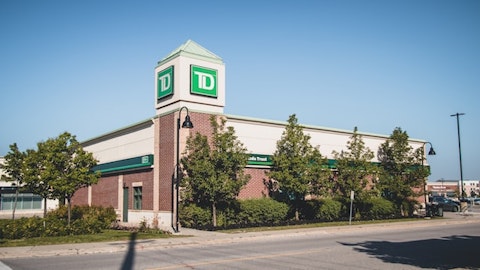Ken Usdin: Thank you. Just a follow-up on the securities portfolio on the AFS side, Alastair, how much of that $180 billion is still swapped? And can you kind of help us understand like what the kind of all-in yield is on that book? And if you would still also have repricing help going forward on that book as well as you mentioned earlier on the HTM maturities?
Alastair Borthwick: Yeah. So most of the book we swapped to floating. We’ve tried to establish that over the course of time. So you can almost think about most all of the available-for-sale securities repricing kind of every day, every week, every two weeks, whatever it may be. So that tends to look a little bit more like the cash tide moves over time. There’s a few securities in there that are fixed rate, but very, very little in terms of the total complexion, Ken.
Ken Usdin: Okay. That helps. Thank you. And then just wanted to also say, on the fee side, obviously, another really good job both on the Investment Bank and the trading businesses, still an uncertain environment. Just wanted to get your thoughts. You were able to hold the IB fees flat sequentially, which was, I think, better than you had indicated. Just your thoughts on reopening here in the markets and how you’re kind of expecting the business to hopefully, albeit understanding it’s still an uncertain environment.
Alastair Borthwick: Yeah. So this is — I suppose, unusual and not unusual. Investment Banking, obviously, has the potential for swings in fees. And what’s interesting about this one is, would that be bouncing around this sort of $1.1 billion per quarter, $1.2 billion per quarter. And normally, investment banking you’d expect to return within a year or so, and we’re now seven quarters into this. So we’ve got a good pipeline. And mostly what I think corporate America and around the world, C-suite executives are looking for, is the confidence that comes from macroeconomic certainty, geopolitical certainty. So for as long as we’ve got the volatility, it’s going to stay in this kind of a range. But if you were to look back in periods past, Investment Banking can come back very, very quickly to a more historical range of kind of $1.3 billion, $1.4 billion, $1.5 billion per quarter. It’s just that we’ve grown tired of predicting when that might be, Ken.
Brian Moynihan: Yeah, Ken, let me give you two other pieces. One, the pipeline still is strong. But more importantly, Matthew and the team have done a good job of building out our capabilities to serve our huge middle market client base, our global commercial banking client base under Wendy’s leadership. And that number is growing quickly, and that’s a market which is, we’re relatively unpenetrated in. We had good market share with our clients that we did business with, but we — meaning investment banking business with, and so that’s generating probably better performance for us than others in terms of holding our position flat relative to up a little bit year-over-year, flat year-over-year versus a down market. So we basically doubled the size of that team, and we’ll double it again. It’s that kind of opportunity for us.
Ken Usdin: Got it. Great. Thank you for the color.
Operator: We’ll take our next question from Manan Gosalia with Morgan Stanley. Please go ahead. Your line is open.
Manan Gosalia: Hi, good morning. So my question was around deposit growth and what level of deposit growth you think you need from here. Should it be in line with loan growth? Or are you happy to let some of the more maybe non-transaction deposits run off? And the reason I ask is because as noted in some of the prior questions, some of our peers are saying that there’s more room for Consumer deposits to reprice higher, especially core checking accounts. It sort of sounds like you disagree with that. So wanted to assess how much you might need to respond if competitors act differently.
Brian Moynihan: So a couple things. One, just broad base, we have a $1.9 trillion deposit, $1 trillion of loan. So we have a tremendously high deposit base. But also, if you think about, if you look at the Slide 5 or whatever, as we show the deposits by business, in the banking business, Global Banking, I think six quarters we’ve been relatively flat, so, and starting to grow off of that. That is fully priced at — it’s not like corporate treasurers wait around to talk to you about what you’re paying and the noninterest-bearing percentage has drifted down. The amount they hold in excess of that, part of that to pay fees has been relatively stable. And so, we feel very good about that. Looking at Wealth Management, basically all the movement was made — has been made pretty much to the higher rate environment, i.e. buying treasury securities directly.
If you look in our Wealth Management business, the amount of short-term cash-oriented type investments, money market funds, et cetera, treasuries, et cetera, has gone from like $500 billion to $700 billion or $800 billion over the last several — last couple of years. So that move has taken place. And so the rest of it is now in a relatively stable base. You can see those numbers flat. If you go to the consumer side, there’s basically two or three things. One is, in the medium income households plus or minus, you’re seeing the slow spend down even though they still have multiples of what they had pre-pandemic in their accounts. And even though that’s a small part of the overall deposit base, there’s still this low trend that where that’s drifting down as all the things you read about go on.





